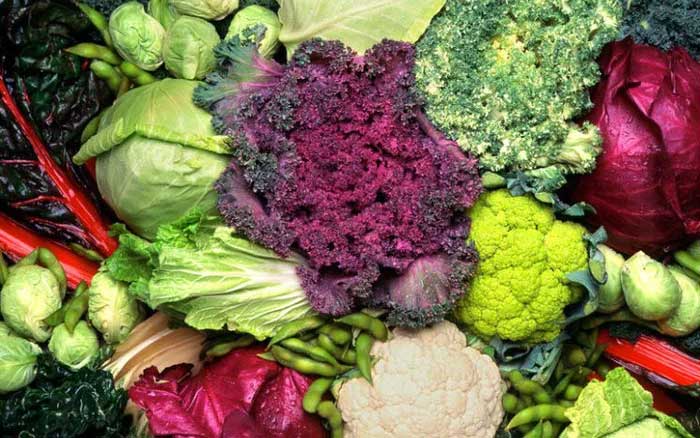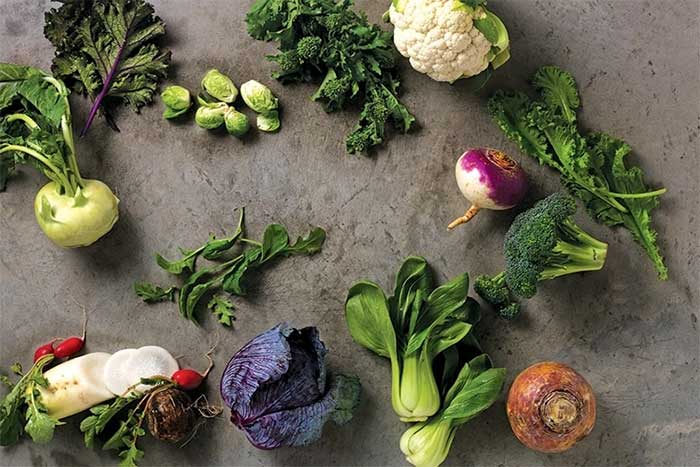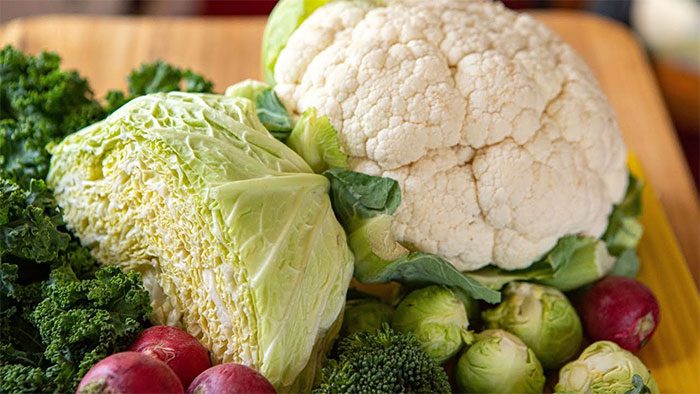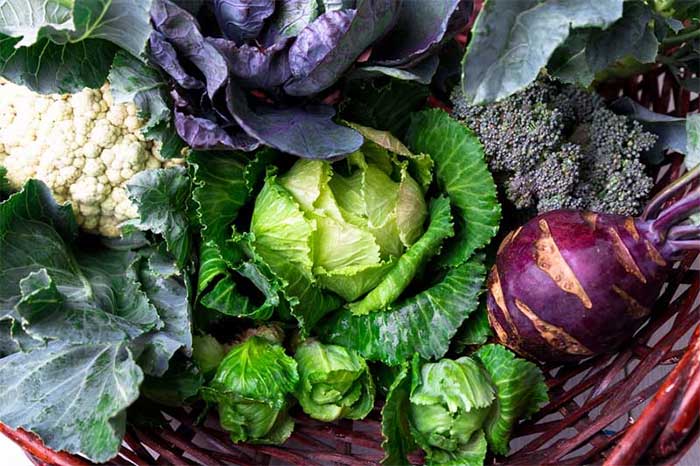When suffering from the flu, an immune-boosting diet will help you recover your health more quickly.
Cruciferous vegetables are a group of green foods rich in essential nutrients that scientists have proven to have many health benefits. By incorporating them into your daily diet, you can reduce the risks associated with chronic diseases, including cancer and heart disease.
There are over 3,000 different types of cruciferous vegetables, the most common being broccoli, cauliflower, kale, Brussels sprouts, spinach, and cabbage, along with watercress and bok choy…
The nutritional value per serving varies among different types of cruciferous vegetables, but generally, they are relatively similar in macronutrient composition. In addition to being a source of vitamin C, folic acid, iron, calcium, and selenium, they are low in calories and contain protein, fat, carbohydrates, fiber, and sugars.
For example, 200g of cooked broccoli contains:
- Calories: 55
- Protein: 4g
- Fat: 1g
- Carbohydrates: 5g
- Sugar: 2g.

Nutritional values per serving vary among different types of cruciferous vegetables. (Image: ST).
Health Benefits of Cruciferous Vegetables
Cruciferous vegetables contain glucosinolates, compounds that give these dark green plants their bitter taste. Studies show that glucosinolates have strong anti-inflammatory and antioxidant properties, helping to protect our cells from damage caused by disease.
Additionally, cruciferous vegetables are also rich in protein, fiber, vitamins, and minerals. Along with glucosinolates, this powerful nutritional composition provides health benefits including:
1. Improving Immunity Against Illness
The nutritional content of cruciferous vegetables is also associated with a reduced risk of chronic diseases such as diabetes, asthma, and Alzheimer’s disease. Research shows that the plant nutrients in these vegetables have antibacterial properties that enhance your immune defenses against disease-causing pathogens.
Regarding the flu
The flu, commonly referred to as influenza, is an infectious disease that affects the upper respiratory tract and can sometimes lead to complications affecting your lungs. It is highly contagious and spreads from person to person through shared drinks, personal hygiene items, and direct contact with droplets from infected individuals.
According to statistics from the World Health Organization (WHO), approximately 5-10% of adults and 20-30% of children worldwide are infected with the flu each year, with around half a million people dying from health-related issues associated with the flu. Previously, the flu was commonly seen in cold seasons, particularly winter and spring, but recently in Vietnam, flu cases have appeared year-round, potentially causing sporadic outbreaks in various localities.

The nutritional content of cruciferous vegetables is also related to reducing the risk of chronic diseases such as diabetes, asthma, and Alzheimer’s disease. (Image: ST).
When caring for someone with the flu, in addition to monitoring for unusual symptoms and using medications to alleviate symptoms, rest and a proper diet will help the patient recover health more quickly. Specifically, individuals with the flu should eat warm, liquid, easily digestible foods and drink plenty of fluids such as oral rehydration solutions, fresh fruit juices, flu-relief porridge, and warm lemon water with honey, especially for the elderly and children.
Researchers have stated that sulforaphane, a chemical found in cruciferous vegetables, activates antioxidant genes and enzymes in specific immune cells, helping to combat free radicals in your body and promoting recovery.
Broccoli, Brussels sprouts
Broccoli is rich in vitamin C, an essential nutrient for boosting the immune system, especially important when ill, such as with the flu. According to the Harvard School of Public Health, vitamin C is a powerful antioxidant that plays a crucial role in fighting infections. Some studies have shown that vitamin C may help reduce the severity and duration of the common cold, which has some symptoms similar to the flu.
Other foods rich in vitamin C include: red or green peppers, kiwi, grapefruit, oranges, or orange juice.
Spinach, kale, and other leafy greens are also sources of vitamins A, C, E, and K and are very rich in iron. Research from NCBI shows that iron is essential for producing immune cells, particularly white blood cells, which help the body combat infections.
Furthermore, vitamin E in leafy greens is a strong antioxidant. Although most research examining the antiviral properties of vitamin E has been conducted on animals, an observational study published in the Journal of Nutrition Research found that supplementing with 200 IU of vitamin E daily can significantly reduce the frequency and severity of lower and upper respiratory infections.

Spinach, kale, and other leafy greens are also sources of vitamins A, C, E, and K and are very rich in iron. (Image: ST).
Additionally, according to the Johns Hopkins Medicine Health Library, cruciferous vegetables also provide substances that optimize immune function in the gut, where a large number of immune cells reside, effectively strengthening the body’s resistance.
You should consider adding them to fruit smoothies or eating them directly with a bit of lemon or olive oil. If you don’t want to eat salad when sick, you can add a little green to chicken soup or stews to take advantage of the best nutrients from various vegetables.
2. Improving Heart Health
A diet rich in fruits and vegetables has always been associated with a lower risk of heart disease. Studies show that cruciferous vegetables support this effect as their glucosinolates help reduce your LDL (bad) cholesterol.
High levels of good cholesterol help keep your arteries free from fat buildup, leading to heart problems and strokes.
Moreover, cruciferous vegetables are rich in omega-3 fatty acids—healthy fats essential for many bodily functions and help maintain good cognitive health, reducing the risk of mental decline and conditions like Alzheimer’s disease.

A diet rich in fruits and vegetables has always been associated with a lower risk of heart disease. (Image: ST)
3. Cancer Prevention
The glucosinolates in cruciferous vegetables have been shown in many studies to have the ability to kill cancer cells and prevent tumor growth. Numerous observational studies have indicated a significantly lower incidence of various cancers in individuals who consume large amounts of cruciferous vegetables, including breast cancer, lung cancer, pancreatic cancer, and stomach cancer.
According to the American Cancer Institute, studies on rats and mice have demonstrated that indoles and isothiocyanates—compounds formed from the breakdown of glucosinolates—help protect cells from damage, deactivate carcinogenic agents, and possess antibacterial and antiviral effects.
Some studies suggest that sulforaphane, found in high concentrations in broccoli, Brussels sprouts, bok choy, and broccoli sprouts, may play a key role in preventing prostate and colorectal cancer.
However, overall, the relationship between cruciferous vegetable consumption and reduced cancer risk in humans remains unclear. Studies are still controversial and require further in-depth research.

The glucosinolates in cruciferous vegetables have been shown in many studies to have the ability to kill cancer cells and prevent tumor growth. (Image: ST).
4. May Support Weight Loss
On average, a serving of cruciferous vegetables provides up to 20% of your daily fiber needs. Studies show that consuming about 30g of fiber daily can help you lose weight, lower blood pressure, and reduce the risk of obesity and diabetes.
Your method of cooking cruciferous vegetables can change their nutritional content. According to WebMD, some nutrients will be diminished if cooked for long periods, including B vitamins, vitamin C, and antioxidants such as flavonoids and beta-carotene.
However, cooking can also make some nutrients easier to absorb, such as vitamin A, iron, and calcium. Therefore, you may prefer steaming vegetables to retain the most nutritional value.


















































